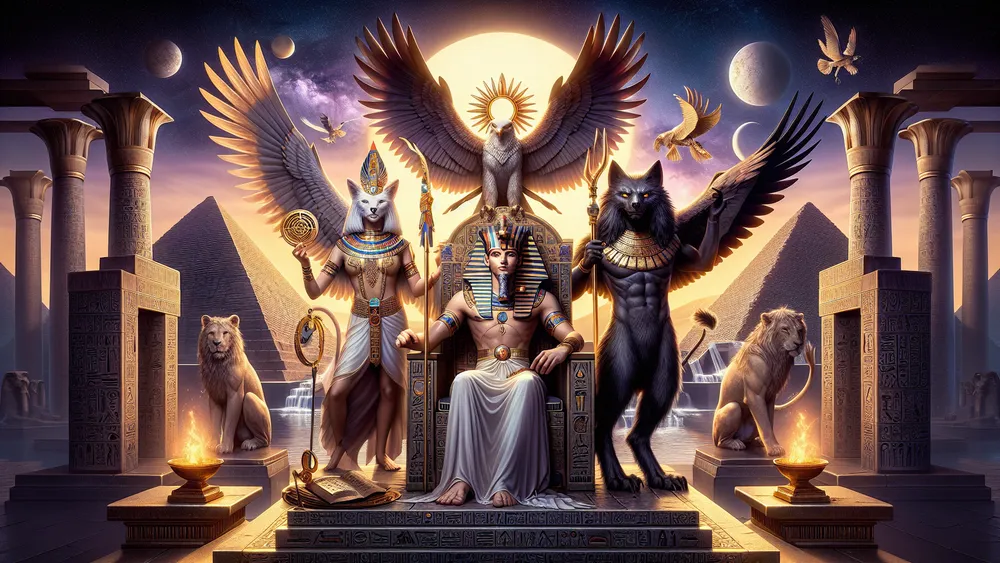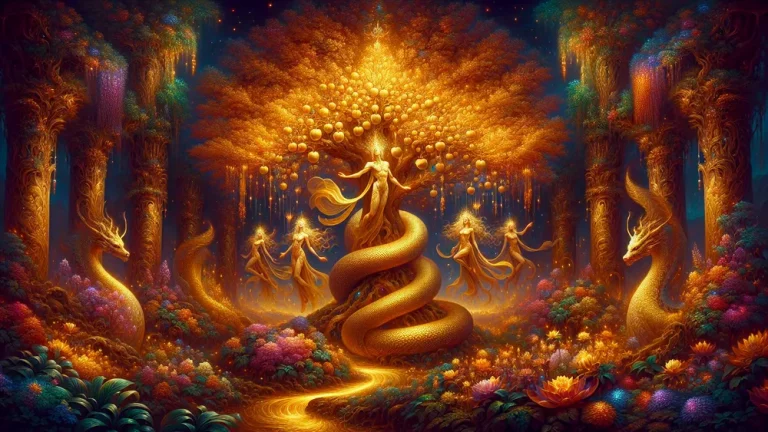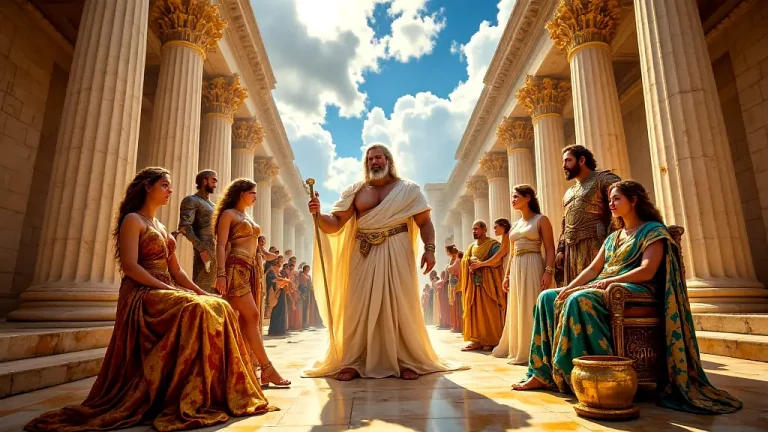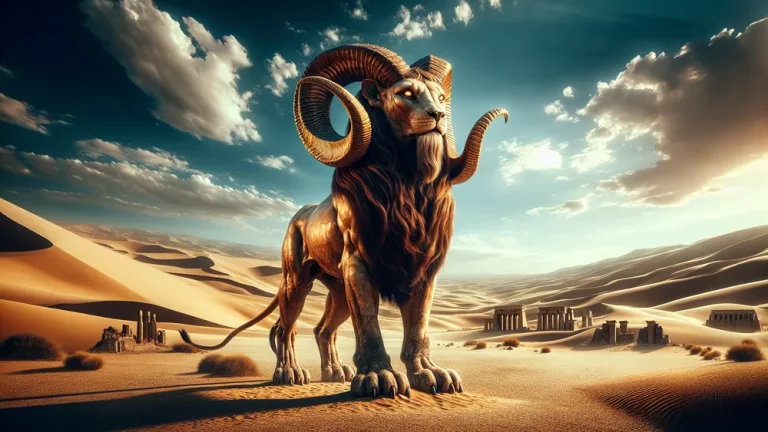Introduction To Egyptian Mythology – A Concise Overview
Welcome to the interesting world of Egyptian mythology, a place where gods and goddesses, stories about making things, and famous tales mix to be the foundation of ancient Egyptian culture. See Egyptian mythology as a big cloth, much like the stories of Greece or Norse lands, but uniquely made for the Nile’s fertile banks.
Key Points:
- Egyptian mythology is a collection of stories about gods and the world.
- Stories explained natural events, creation, and life after death.
- Mythology influenced ancient Egyptian society, including governance and religion.
- Main sources of Egyptian mythology are religious texts, pyramids, and temples.
- Important gods include Ra, Osiris, Isis, and Horus, each with specific roles.
- Creation stories from Heliopolis and Memphis explain how the world began.
- Symbols like the ankh, scarab beetle, and Eye of Horus are common in Egyptian myths.
This mythology was a guidebook for the ancient Egyptians, helping them understand life, death, and the cosmos. This blog post, in it, you’ll start a journey through the key aspects of Egyptian mythology. From the powerful gods of the Ennead to the interesting creation stories of Heliopolis and Memphis. You will also find out how these ancient stories affect modern media and culture.
So, if you are new to mythology or know a lot about it, this short overview will give you a solid base in the old, never-ending story of Egyptian mythology.
| Main Point | Explanation |
|---|---|
| What Egyptian Mythology Is | Egyptian mythology is made up of a collection of stories from ancient Egypt that tell about the actions of gods and the nature of the world. These stories were very important to the culture and religion of that time. |
| Importance in Old Times | Stories were used to explain natural happenings, how the world was made, and what happens after death. They also supported the pharaohs’ rights and the social order. |
| Stories vs. Religion | While related, mythology means the stories and legends, whereas religion is about the rituals, practices, and worship of gods. |
| Main Sources | The main sources of Egyptian mythology have religious texts like the Pyramid Texts, Coffin Texts, and the Book of the Dead, and also writings on temples and monuments. |
| Impact from Nearby Cultures | Egyptian mythology was impacted by, and also impacted, nearby cultures like those from Mesopotamia, Nubia, and later Greece and Rome. |
| Key Historical Events | Events like the unification of Upper and Lower Egypt, the start of pharaonic dynasties, and interactions with other civilizations shaped the growth of Egyptian mythology. |
| Main Gods and Goddesses | Important gods and goddesses are Ra, Osiris, Isis, Horus, Anubis, and Hathor, each having specific roles and traits. |
| Stories of Creation | Different stories, such as those from Heliopolis and Memphis, explain how the world and gods came to be. |
| Symbols in Myths | Symbols like the ankh, scarab beetle, and Eye of Horus were common in stories and had big meanings related to life, safety, and power. |
| Ongoing Impact | Egyptian mythology continues to impact modern culture. It shows up in movies, books, and video games, and also affects current religious and spiritual practices. |
To fully understand the fullness and richness of Egyptian stories, you need to know what these stories are and how they formed old Egyptian culture.
Egyptian mythology explained natural events, origins, and the afterlife, reinforcing social norms and the pharaoh’s authority, with stories distinguished from religious practices found in texts, pyramids, and temples.
What Are Egyptian Myths?
Egyptian mythology is a collection of stories and legends. Old Egyptians used them to explain the world around them. Much like a collection of stories, it gave answers to big life questions. These stories were important in old Egyptian culture. They helped explain natural happenings, how the world came to be, and what happens after death. They also reinforced the social order and the divine right of pharaohs. You need to tell the difference between stories and religion in old Egypt. Stories are about gods and legends. And, religion includes rituals, practices, and worship of the gods. The main sources of Egyptian mythology have:
- Religious Texts: Like the Pyramid Texts, Coffin Texts, and the Book of the Dead.
- Pyramids: Buildings that often had writings and texts related to myths.
- Temples: Places where stories were shown in carvings and paintings, and where rituals happened.
By knowing these sources, one can get a deeper understanding of how these old stories have been kept and passed down.
Where It All Began
To really see the start and growth of Egyptian stories, it’s important to look at its early growth and the historical events that formed them.
How Egyptian Myths Started
The start of Egyptian stories can be found during the Pre-Dynastic period. This was before Upper and Lower Egypt joined, a time when early religious ideas and practices began to form. Back then, Egyptians began to make their group of gods and goddesses, and this set the stage for the rich mix of stories that came later. The impact of nearby cultures, like the Mesopotamians and Nubians, also helped shape these early stories. For instance, the idea of a divine leader and some gods were shared and adjusted among these groups. Big historical events also changed the course of Egyptian stories. These include:
- Joining of Upper and Lower Egypt: This event led to mixing different regional gods and stories.
- Formation of Pharaonic Dynasties: The divine role of pharaohs widened the myth framework.
- Contacts with Other Civilizations: Trade and conquest brought new ideas and tales into Egyptian myths.
By knowing these early impacts and events, you can see how Egyptian stories changed into a detailed and interesting belief system.
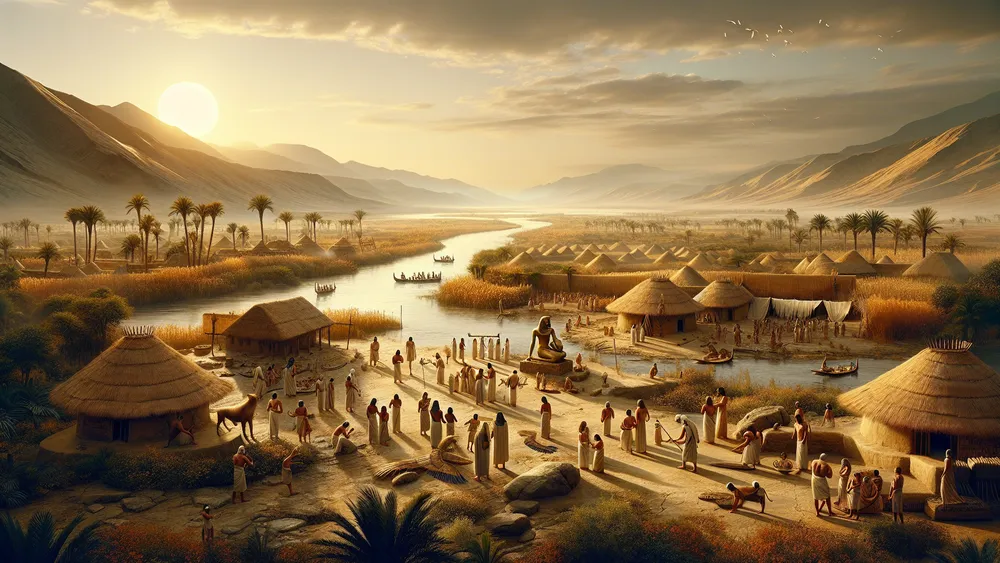
Important Gods and Their Jobs
Now that we’ve looked at the starts and growth of Egyptian stories, let’s look into the main gods and their jobs in this complex belief system.
The Nine Big Gods of Heliopolis
The group of nine gods from Heliopolis forms the center of one of the most important storytelling systems in old Egypt. This group includes Atum, Shu, Tefnut, Geb, Nut, Osiris, Isis, Set, and Nephthys. Atum, the maker god, came out of the first waters and made the first pair of gods, Shu (god of air) and Tefnut (goddess of wetness).
Shu and Tefnut then had Geb (god of the ground) and Nut (goddess of the sky). Geb and Nut, and then had four kids: Osiris, Isis, Set, and Nephthys. Osiris became god of the afterlife; Isis was the goddess of magic and mothers; Set known as god of chaos and anger; Nephthys for funeral rites and watching over people.
This group’s relationships and jobs are like a complex family tree, where every god and goddess have special tasks and interactions with each other. Atum, the starter, holds central position, while Shu and Tefnut stand for air and wet things that keep life going. Geb and Nut show the ground and sky, which make the physical world. Osiris and Isis are important to the story of death and coming back to life, with Osiris watching the underworld and Isis using magic skills to watch over and bring him back. Set, the opponent, stands for disorder and fights, often fighting with Horus, Osiris and Isis’s son. Nephthys, not as big a name, plays a key role in funeral setups and giving protection. Here is a table showing the roles and signs linked to each god:
| God | Job/Role | Sign(s) |
|---|---|---|
| Atum | Maker god | Pyramidal mound, snake |
| Shu | God of air | Ostrich feather |
| Tefnut | Goddess of wetness | Lioness |
| Geb | God of the ground | Goose, green skin |
| Nut | Goddess of the sky | Stars, sky |
| Osiris | God of the afterlife | Crook and flail, white crown |
| Isis | Goddess of magic and mothers | Throne, ankh |
| Set | God of chaos and anger | Set animal (unknown species) |
| Nephthys | Goddess of funeral rites | House, basket |
By knowing the jobs and links of these gods, you can better see the detailed and linked nature of Egyptian storytelling.
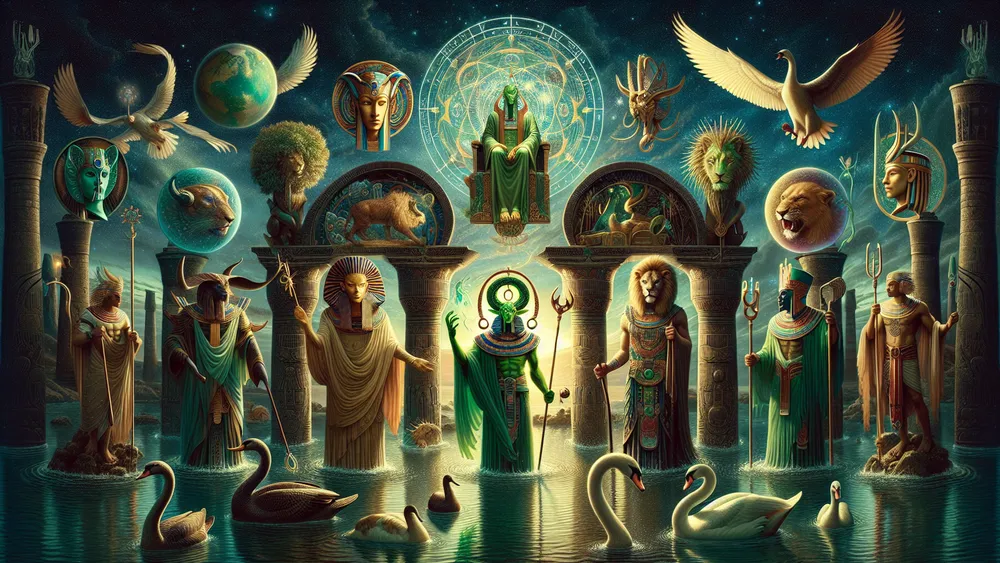
Other Famous Gods and Goddesses
Also, many other gods and goddesses had important jobs in Egyptian stories. Anubis, the jackal-headed god, was the god of preserving and the afterlife. He guided souls to the underworld and watched over embalming. Horus, shown as a falcon, was the god of the sky and kings. He avenged his father Osiris and fought Set to rule Egypt.
Thoth, with the head of an ibis, was the god of smarts, writing, and knowledge. He made hieroglyphs and kept the universe’s control. Hathor, the cow-headed goddess, was tied to love, beauty, music, and mothers. She was often seen as a caring figure for the dead.
These gods have many stories showing their importance. Anubis leads the “Weighing of the Heart” ceremony, deciding souls’ fates after death. Horus’s main story has him fighting Set, showing the battle between order and chaos. Thoth is in many stories as a mediator and wise counselor, like in the “Contendings of Horus and Set,” deciding the fight between them. Hathor’s stories show her protective side, like in the “Eye of Ra” story. She turns into lioness Sekhmet to punish humans but calms down and becomes kind again. Here is a list showing the main stories for each god:
- Anubis: “Weighing of the Heart” ceremony
- Horus: Fights with Set, “Contendings of Horus and Set”
- Thoth: Mediator in many stories, known for hieroglyphs
- Hathor: “Eye of Ra,” watches over the dead
By looking at these gods and their stories, you can better understand the varied and connected nature of Egyptian storytelling.
How the World Started (According to Egyptians)
We have looked at the main gods and their jobs. Now, let’s look into the interesting beginning stories that tell how old Egyptians thought the world started.
The Creation Story from Heliopolis
In their creation story, the world started with the god Atum. He came out from the first waters of Nun, meaning the start of life from disorder. Atum, showing a god who made himself, stood on the first mound of earth. And he made the first pair of gods, Shu (air) and Tefnut (wetness), by making them himself. Shu and Tefnut then had Geb (earth) and Nut (sky).
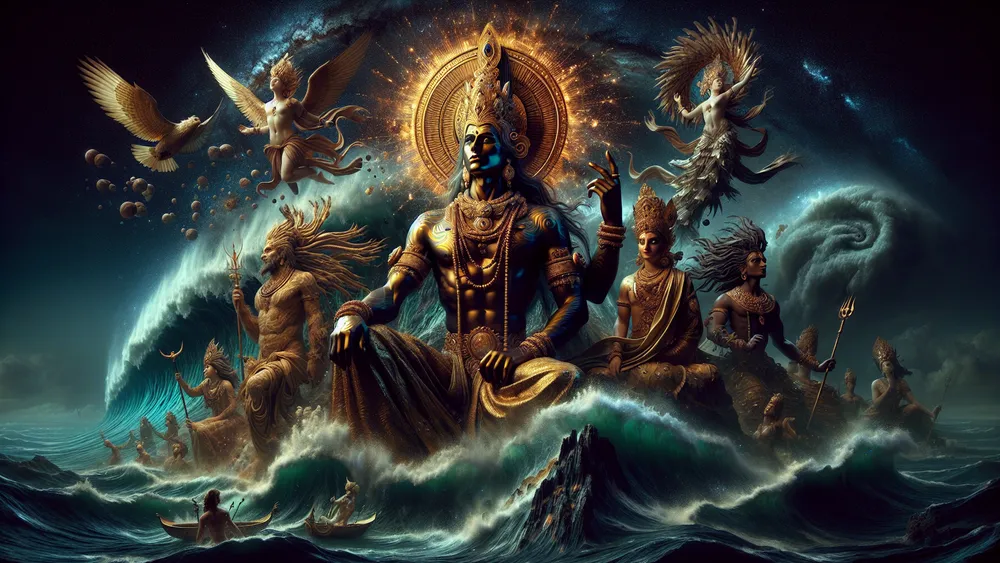
They later had Osiris, Isis, Set, and Nephthys, finishing the group of nine. This story not just tells how the gods began but also shows how order came from disorder, a critical idea in old Egyptian way of life.
The story of Atum’s making was important because it supported the idea that the king, seen as a god ruler, was a force keeping Ma’at (control) in the world, like Atum did at the beginning of time.
The Creation Story from Memphis
The Memphite creation myth focuses on Ptah, the god of workers and builders. He brought the world into life using thinking and talking. Unlike the Heliopolitan myth, where Atum makes the first gods by doing things himself, Ptah’s creation is more about smart ideas and talking. In this myth, Ptah thought of the world in his heart.
Then he talked it into being, showing the power of words and thought in making things. This way of creating shows the value of smart thinking and talking in old Egyptian life. Both myths have the idea of order coming from disorder, but they are very different in how they show the creator god and how things get made.
The Heliopolitan myth is about physical acts by Atum, while the Memphite myth shows the creative power of Ptah’s mind and talking, showing a more thoughtful way of how the universe started.
Ptah’s creation myth emphasizes the power of thought and speech in bringing the world into existence, contrasting with the physical actions of Atum in the Heliopolitan myth.
Big Stories and Legends
Now that we have looked at the creation myths, it’s time to look into some of the most interesting big tales and myths which formed ancient Egyptian thoughts.
The Story of Osiris
The Osiris story is one of the most big and famous stories in Egyptian mythology. It starts with Osiris, the good king of Egypt, who got tricked by his envious brother Set. Set tricked Osiris into lying in a nicely made box. He then closed it and threw it into the Nile River, causing Osiris’s death.
Isis, Osiris’s loyal wife, looked hard for his body and finally found it. Using her magic skills, she brought Osiris back long enough to have their son, Horus. But, Osiris could not stay in the world of the living, so he went down to the land of the dead, becoming the god of the afterlife and deciding the dead people’s fate.
This story not only shows the themes of trickery, death, and coming back but also shows the power of love. The importance of the Osiris story in Egyptian religion is really big. Osiris coming back meant the promise of forever life and the chance of being born again, which was a main idea in old Egyptian thoughts about life after death.
The story also made Osiris the boss of the land of the dead, where he watched over the decision of souls, deciding their end in the next world. Horus, the son of Osiris and Isis, played a big part in getting back at his father’s death. He fought in many big battles with Set, finally winning and bringing back order to Egypt.
Horus’s win over Set meant the win of good over evil and the bringing back of Ma’at, the idea of cosmic order and steady. This story supported the god’s right of the pharaohs, who were thought to be the earthly form of Horus, making sure the keeping going of order and fairness in the world.
Ra’s Daily Journey
Ra, the sun god, started a daily trip that was important to Egyptian worldview. Every morning, Ra would rise in the east and move across the sky in his sun boat, bringing light and life to everyone. When evening came, Ra would go down in the west, going into the land of the dead, called Duat.
At night, he navigated through the dangerous places of the underworld and fought chaos and darkness, shown by the snake Apophis. This nightly trip was important because it made sure the sun would rise again and keep the day and night going. Ra’s trip showed the eternal circle of life, death, and rebirth, copying the farming cycles that were important to the Egyptians.
It also supported the idea of Ma’at, the order of the universe, because Ra’s win over darkness every night showed the win of order over chaos, making sure the universe stayed stable and in harmony.
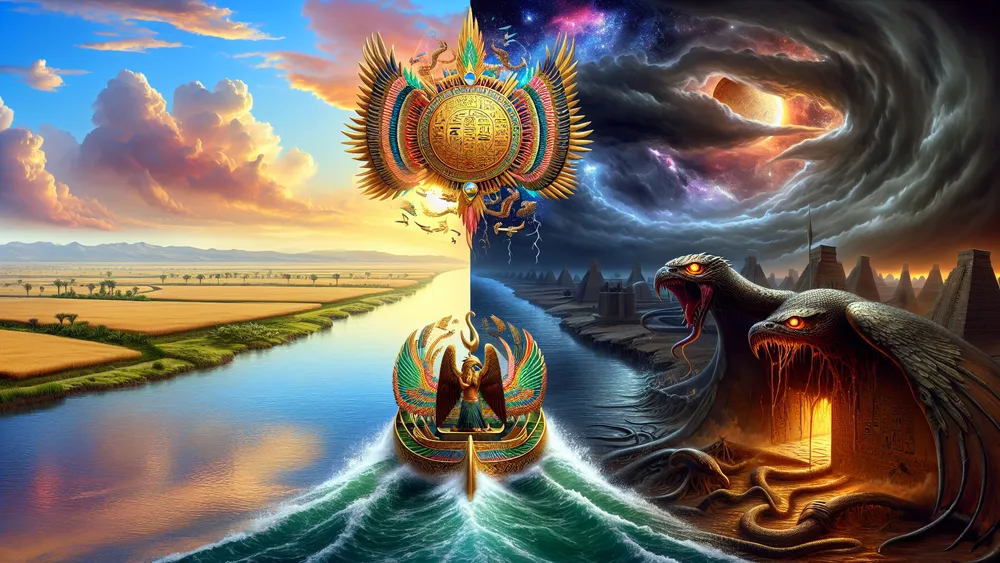
Symbols and Images
Now that we have looked at the interesting myths and legends, let’s look into the full set of symbols and images that fill Egyptian mythology.
Everyday Symbols in Egyptian Myths
In Egyptian stories, many symbols had deep ideas and were important to both beliefs and burial practices. The ankh, called the “key of life,” meant forever life and was often shown in the hands of gods and kings. The scarab beetle, showing rebirth and change, was often used in charms and put in tombs to make sure the dead passed safely to the next world. The Eye of Horus, called the “Wadjet,” meant safety, health, and healing. These symbols, not just decorations, played important roles in ceremonies and were thought to have magical powers. For example, the ankh was put in tombs to promise the dead person’s forever life, while the Eye of Horus kept away bad things. Some of the big symbols are:
- Ankh: Idea of forever life.
- Scarab Beetle: Shows rebirth and change.
- Eye of Horus (Wadjet): Means safety, health, and healing.
These symbols filled every part of Egyptian life, acting as strong tools to connect the real world with the gods.
Animals in Egyptian Myths
Animals had very important roles in Egyptian stories. They often showed the traits and powers of the gods they were connected with. Cats, for instance, were respected for their protecting traits and tied to the goddess Bastet, who meant home, babies, and childbirth. Crocodiles, however, were tied to the god Sobek, showing strength and power, and people thought they guarded the Nile and its folks.
Falcons were special to Horus, the sky god, and they meant royalty and godly safety. These animals were not just symbols; they were important to religious events and daily life. For example, cats were kept at home to call on Bastet’s protection, while falcon images decorated temples to honor Horus.
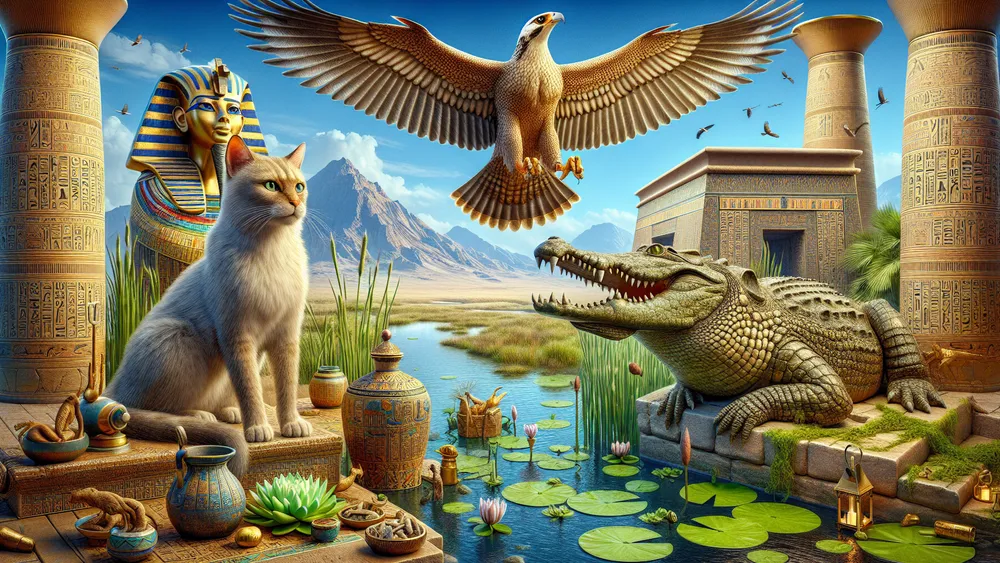
Respect for these animals can be similar to how some cultures today respect certain animals, like the cow in Hinduism. This deep connection between animals and gods shows that Egyptians believed all life and the divine were strongly connected.
Egyptian Myths Today
Now that we have looked at the full set of symbols and animals in Egyptian stories, let us check how these old stories still affect today’s world.
Egyptian Myths in Movies and Games
Egyptian mythology has found an important place in today’s stuff, making it interesting for people through movies, books, and video games. Movies like “The Mummy” series and “Gods of Egypt” show old gods and stories with big scenes, while video games like “Assassin’s Creed: Origins” put players in a very detailed old Egypt, complete with story parts.
However, these new ways often change the characters and stories to fit today’s stories and fun needs. For example, even though the old Egyptians respected Anubis as the god of mummification and the afterlife, new pictures might show him as a simple figure of death.
These new versions, although fun, can be much different from the old stories, which were directly tied to religious practices and ways of that time. By checking these new versions against the old ones, we can see both the old-time charm of Egyptian stories and how they still make and change in today’s world.
How Egyptian Myths Leave Their Mark
Egyptian mythology still has a strong influence on today’s faith and soul-related activities and also on current art and books. Many New Age and neo-pagan soul-related groups use Egyptian signs like the ankh and the Eye of Horus in their actions. This is similar to how old signs are used in other faith practices today to call on specific powers or gods.
In the area of art and books, Egyptian mythology led to many works, from dream-like pictures by Salvador Dalí, which often show Egyptian themes, to books like Rick Riordan’s “The Kane Chronicles,” that redo old stories for young readers. These new versions and additions show the lasting attraction of Egyptian stories, showing how they go beyond time and still make an impact.
By seeing these links, we can see how the old Egyptian stories and signs keep being important and strong in today’s world.
FAQs
1. What are the main sources of Egyptian mythology?
The main sources of Egyptian mythology include religious texts, pyramids, and temples.
2. How did Egyptian mythology influence ancient Egyptian society?
Egyptian mythology influenced ancient Egyptian society by shaping their religious practices, governance, and cultural values.
3. What is the significance of the Osiris myth?
The significance of the Osiris myth lies in its profound influence on ancient Egyptian concepts of kingship, the afterlife, and resurrection.
4. How are animals represented in Egyptian mythology?
Animals in Egyptian mythology are often depicted as sacred beings associated with specific deities and symbolic meanings.

